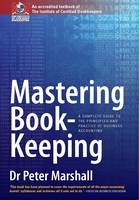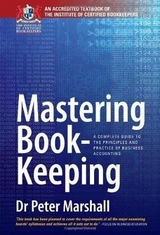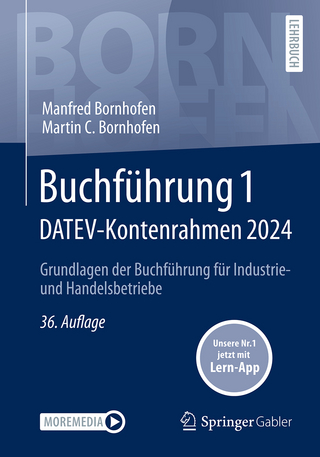
Mastering Book-keeping
How To Books Ltd (Verlag)
978-1-84528-324-7 (ISBN)
- Titel erscheint in neuer Auflage
- Artikel merken
Double-entry accounting can be easy if it's explained well, and Mastering Book-keeping does just that. Now in its updated 8th edition, this popular book has helped thousands of people to get to grips with book-keeping. It explains the principles and practice of book-keeping sequentially, and includes: - The daybooks and ledger accounts - End of year accounting - Sole proprietorships, limited companies, partnerships and not-for-profit organisations - Using computers for accounting - Accounting for VAT - Progressing to more advanced management accounting - The implications of the Data Protection Act 1998 on book-keepers. Plus step-by-step guides to compiling a balance sheet, depreciation, accounting for bad and doubtful debts, and much more. Everything is made clear with easy-to-follow explanations. Typical transactions are illustrated throughout to make the information even easier to understand. This book is suitable for those preparing for the examinations of ICB, AAT, IAB, OCR, AQA and all other courses in book-keeping and accounts.
PETER MARSHALL BA BSc (Econ) PhD is a professional educator in business subjects. He is also a prolific author whose books have been translated and sold worldwide.
Preface; 1. A period of transition; 2. The role and significance of the professional association; 3. Data security and the Data protection Act 1998; 4. The flow of documents and processes; 5. What is double entry book-keeping?; 6. Opening the books of account; 7. The day books; 8. The purchase day book; 9. The purchase returns day book; 10. The sales day book; 11. The sales returns day book; 12. The cash book; 13. The cash book: money paid in; 14. The cash book: money paid out; 15. Disagreeing with the bank; 16. The bank reconciliation; 17. The petty cash book; 18. How to write up the petty cash book; 19. The journal; 20. How to write up the journal; 21. The postage book; 22. The ledger; 23. Posting to the ledger from the day books; 24. Posting to the ledger from the cash book; 25. Balancing the ledger; 26. Discounts; 27. Control accounts; 28. Preparing control accounts step by step; 29. The trial balance; 30. How to extract a trial balance; 31. The trial balance: errors; 32. Accruals and prepayments; 33. Revenue accounts; 34. Stock in the final accounts; 35. How to compile revenue accounts; 36. Compiling revenue accounts step by step; 37. The balance sheet; 38. Compiling a balance sheet step by step; 39. Manufacturing accounts; 40. Compiling a manufacturing account step by step; 41. Depreciation: the straight line method; 42. Depreciation: the diminishing balance method; 43. Other methods of depreciation; 44. Depreciation step by step; 45. Accounting for bad and doubtful debts; 46. Accounting for bad and doubtful debts step by step; 47. Partnership accounts; 48. Partnerships: appropriation accounts; 49. Partnership accounts step by step; 50. Amalgamating sole proprietorships into a partnership; 51. How to consolidate two balance sheets; 52. Limited companies; 53. Limited companies' books and accounts; 54. Format of company accounts; 55. Revenue accounts of limited companies; 56. Balance sheets of limited companies; 57. Going limited; 58. Going limited: worked example; 59. Club accounts; 60. Club accounts: income and expenditure; 61. Fixed asset register; 62. Asset disposals; 63. Asset disposals step by step; 64. Correction of errors; 65. Correcting errors step by step; Contents; 66. Value Added Tax; 67. Accounting for VAT; 68. Incomplete records; 69. Capital comparison method step by step; 70. Bank account analysis step by step; 71. Interpreting accounts; 72. Interpreting accounts: example; 73. Wages: basic principles; 74. Coin analysis and wages book; 75. Stock records and valuation; 76. Encountering deviations from standard methods; 77. Using spreadsheet pages; 78. New developments in electronic book-keeping; 79. More advanced accounting; Sample examination papers - Level I; Model answers - Level I; Sample examination papers - Level II; Model answers - Level II; Sample examination papers - Level III; Model answers - Level III; More sample examination papers; Glossary; Index.
| Erscheint lt. Verlag | 27.3.2009 |
|---|---|
| Zusatzinfo | Illustrations |
| Verlagsort | London |
| Sprache | englisch |
| Maße | 153 x 233 mm |
| Themenwelt | Wirtschaft ► Betriebswirtschaft / Management ► Rechnungswesen / Bilanzen |
| ISBN-10 | 1-84528-324-4 / 1845283244 |
| ISBN-13 | 978-1-84528-324-7 / 9781845283247 |
| Zustand | Neuware |
| Informationen gemäß Produktsicherheitsverordnung (GPSR) | |
| Haben Sie eine Frage zum Produkt? |
aus dem Bereich



